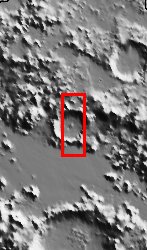
Released 12 December 2003
Man, there sure is a lot going on here! This image was acquired during the peak of the late October record breaking solar storm outbursts. The white dots in this image were in fact caused when the charged particles from the sun hit our camera. One can also see the enigmatic gullies, dark barchan sand dunes and numerous dust devil tracks. This image is in the Noachis region of the heavily cratered southern hemisphere.
Image information: VIS instrument. Latitude -42.1, Longitude 328.2 East (31.8 West). 19 meter/pixel resolution.
Note: this THEMIS visual image has not been radiometrically nor geometrically calibrated for this preliminary release. An empirical correction has been performed to remove instrumental effects. A linear shift has been applied in the cross-track and down-track direction to approximate spacecraft and planetary motion. Fully calibrated and geometrically projected images will be released through the Planetary Data System in accordance with Project policies at a later time.
NASA's Jet Propulsion Laboratory manages the 2001 Mars Odyssey mission for NASA's Office of Space Science, Washington, D.C. The Thermal Emission Imaging System (THEMIS) was developed by Arizona State University, Tempe, in collaboration with Raytheon Santa Barbara Remote Sensing. The THEMIS investigation is led by Dr. Philip Christensen at Arizona State University. Lockheed Martin Astronautics, Denver, is the prime contractor for the Odyssey project, and developed and built the orbiter. Mission operations are conducted jointly from Lockheed Martin and from JPL, a division of the California Institute of Technology in Pasadena.

